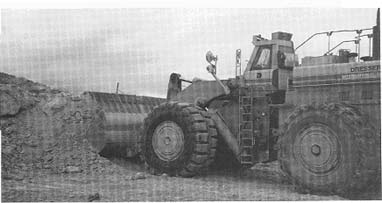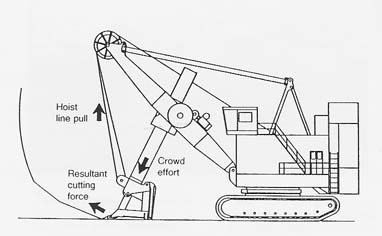|

Muck Pile
This is an example of a good muck pile, well-fragmented
and largely remaining in one heap. Loading would be much more time consuming
if the rock were widely dispersed, as it might be by conventional blasting
in a low-gravity environment, without air resistance. The loading machine
must have sufficient traction (created by both friction and weight) to
be able to push the loading bucket into the muck pile.
|
Lunar mining may involve the removal of various types of ground, ranging from
massive solid rock to loose, granular soils. This possibility suggests the need to investigate a range of
material- removal technologies. It may be desirable, at this early investigation stage, to distinguish between
the fundamental mechanics underlying the technologies and the technologies themselves. Both will be affected by
operations on the Moon, but in different ways.
a. Hard rock excavation mechanics
In earthbound mining, hard rock is removed primarily by explosive excavation. Lunar blast design is likely
to require significant changes from conventional blasting. An obvious consideration will be the need to
control the broken rock pile. It is usually assumed that gravity plays no role in actual rock breakage by
conventional blasting, but it plays a significant role in displacement of the broken rock (and thus dominates
the shape of the muck pile). Low gravity could result in extremely wide scattering of rock fragments, even more
so in the absence of air resistance, and hence lead to exceedingly inefficient loading operations. An interesting
challenge may be posed by the need to adjust blasting patterns from the traditional ones to those designed to
minimize scatter in a low-gravity and high-vacuum environment.
It is possible that vacuum might affect blasting performance,
although it may not be a significant factor in low-permeability rock,
at least at greater depths. The breakage induced by blasting is usually
attributed in part to seismic effects and in part to gas pressure effects.
Presumably gas pressure effects could attenuate much faster in a space
environment than on Earth. This could affect fragmentation and almost
certainly would affect heave and throw; i.e., rock movement.
Potential impacts of low gravity on mechanical excavation have been discussed
under topic 1. Drastically different excavation technologies are summarized
by Maurer (1980), and they deserve intense scrutiny for lunar applications.
b. Soft ground excavation mechanics
Mechanical excavation of loose, granular material on the lunar surface is likely to be facilitated
by the lower gravity in terms of actually lifting the material, although this improvement may be partially
offset by increased friction between particles. It is likely that the most significant detrimental effect
will be on the forces that can be delivered by the equipment. Reduced equipment weight will reduce breakout
forces and sliding stability. It is quite possible that even a simple force analysis of excavation systems
will shed considerable light on lunar soil loading requirements and potential problems. Gertsch has suggested
that we add mass to lunar equipment by building into it large volumes to be filled with lunar rocks. However,
as he notes, the added mass would add to the problem of inertia in mobile equipment.
|

